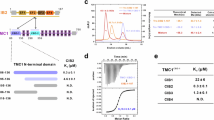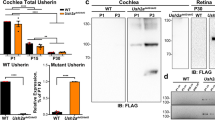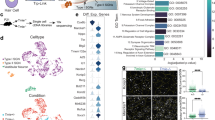Abstract
Sensorineural hearing loss is genetically heterogeneous. Here, we report that mutations in CIB2, which encodes a calcium- and integrin-binding protein, are associated with nonsyndromic deafness (DFNB48) and Usher syndrome type 1J (USH1J). One mutation in CIB2 is a prevalent cause of deafness DFNB48 in Pakistan; other CIB2 mutations contribute to deafness elsewhere in the world. In mice, CIB2 is localized to the mechanosensory stereocilia of inner ear hair cells and to retinal photoreceptor and pigmented epithelium cells. Consistent with molecular modeling predictions of calcium binding, CIB2 significantly decreased the ATP-induced calcium responses in heterologous cells, whereas mutations in deafness DFNB48 altered CIB2 effects on calcium responses. Furthermore, in zebrafish and Drosophila melanogaster, CIB2 is essential for the function and proper development of hair cells and retinal photoreceptor cells. We also show that CIB2 is a new member of the vertebrate Usher interactome.
This is a preview of subscription content, access via your institution
Access options
Subscribe to this journal
Receive 12 print issues and online access
$259.00 per year
only $21.58 per issue
Buy this article
- Purchase on SpringerLink
- Instant access to full article PDF
Prices may be subject to local taxes which are calculated during checkout






Similar content being viewed by others
Accession codes
Change history
26 August 2025
A Correction to this paper has been published: https://doi.org/10.1038/s41588-025-02332-w
References
Ahmad, J. et al. DFNB48, a new nonsyndromic recessive deafness locus, maps to chromosome 15q23-q25.1. Hum. Genet. 116, 407–412 (2005).
Ahmed, Z.M., Riazuddin, S., Khan, S.N., Friedman, P.L. & Friedman, T.B. USH1H, a novel locus for type I Usher syndrome, maps to chromosome 15q22–23. Clin. Genet. 75, 86–91 (2009).
Adzhubei, I.A. et al. A method and server for predicting damaging missense mutations. Nat. Methods 7, 248–249 (2010).
Schwarz, J.M., Rodelsperger, C., Schuelke, M. & Seelow, D. MutationTaster evaluates disease-causing potential of sequence alterations. Nat. Methods 7, 575–576 (2010).
Gentry, H.R. et al. Structural and biochemical characterization of CIB1 delineates a new family of EF-hand–containing proteins. J. Biol. Chem. 280, 8407–8415 (2005).
Blazejczyk, M. et al. Biochemical characterization and expression analysis of a novel EF-hand Ca2+ binding protein calmyrin2 (Cib2) in brain indicates its function in NMDA receptor mediated Ca2+ signaling. Arch. Biochem. Biophys. 487, 66–78 (2009).
Huang, H., Ishida, H., Yamniuk, A.P. & Vogel, H.J. Solution structures of Ca2+-CIB1 and Mg2+-CIB1 and their interactions with the platelet integrin αIIb cytoplasmic domain. J. Biol. Chem. 286, 17181–17192 (2011).
Huang, H. & Vogel, H.J. Structural basis for the activation of platelet integrin αIIbβ3 by calcium- and integrin-binding protein 1. J. Am. Chem. Soc. 134, 3864–3872 (2012).
Häger, M. et al. Cib2 binds integrin α7Bβ1D and is reduced in laminin α2 chain–deficient muscular dystrophy. J. Biol. Chem. 283, 24760–24769 (2008).
Kasri, N.N. et al. Regulation of InsP3 receptor activity by neuronal Ca2+-binding proteins. EMBO J. 23, 312–321 (2004).
Hennigs, J.K. et al. Sweet taste receptor interacting protein CIB1 is a general inhibitor of InsP3-dependent Ca2+ release in vivo. J. Neurochem. 106, 2249–2262 (2008).
Mammano, F. et al. ATP-induced Ca2+ release in cochlear outer hair cells: localization of an inositol triphosphate–gated Ca2+ store to the base of the sensory hair bundle. J. Neurosci. 19, 6918–6929 (1999).
White, C., Yang, J., Monteiro, M.J. & Foskett, J.K. CIB1, a ubiquitously expressed Ca2+-binding protein ligand of the InsP3 receptor Ca2+ release channel. J. Biol. Chem. 281, 20825–20833 (2006).
Beurg, M., Nam, J.H., Chen, Q. & Fettiplace, R. Calcium balance and mechanotransduction in rat cochlear hair cells. J. Neurophysiol. 104, 18–34 (2010).
Reiners, J., Nagel-Wolfrum, K., Jurgens, K., Marker, T. & Wolfrum, U. Molecular basis of human Usher syndrome: deciphering the meshes of the Usher protein network provides insights into the pathomechanisms of the Usher disease. Exp. Eye Res. 83, 97–119 (2006).
van Wijk, E. et al. The DFNB31 gene product whirlin connects to the Usher protein network in the cochlea and retina by direct association with USH2A and VLGR1. Hum. Mol. Genet. 15, 751–765 (2006).
Belyantseva, I.A. et al. Myosin-XVa is required for tip localization of whirlin and differential elongation of hair-cell stereocilia. Nat. Cell Biol. 7, 148–156 (2005).
Gale, J.E., Marcotti, W., Kennedy, H.J., Kros, C.J. & Richardson, G.P. FM1-43 dye behaves as a permeant blocker of the hair-cell mechanotransducer channel. J. Neurosci. 21, 7013–7025 (2001).
Meyers, J.R. et al. Lighting up the senses: FM1-43 loading of sensory cells through nonselective ion channels. J. Neurosci. 23, 4054–4065 (2003).
Seiler, C. et al. Myosin VI is required for structural integrity of the apical surface of sensory hair cells in zebrafish. Dev. Biol. 272, 328–338 (2004).
Seiler, C. & Nicolson, T. Defective calmodulin-dependent rapid apical endocytosis in zebrafish sensory hair cell mutants. J. Neurobiol. 41, 424–434 (1999).
Lumpkin, E.A. & Hudspeth, A.J. Regulation of free Ca2+ concentration in hair-cell stereocilia. J. Neurosci. 18, 6300–6318 (1998).
Denk, W., Holt, J.R., Shepherd, G.M. & Corey, D.P. Calcium imaging of single stereocilia in hair cells: localization of transduction channels at both ends of tip links. Neuron 15, 1311–1321 (1995).
Fettiplace, R. & Ricci, A.J. Adaptation in auditory hair cells. Curr. Opin. Neurobiol. 13, 446–451 (2003).
Brandt, A., Striessnig, J. & Moser, T. CaV1.3 channels are essential for development and presynaptic activity of cochlear inner hair cells. J. Neurosci. 23, 10832–10840 (2003).
Fuchs, P.A., Glowatzki, E. & Moser, T. The afferent synapse of cochlear hair cells. Curr. Opin. Neurobiol. 13, 452–458 (2003).
Dulon, D., Zajic, G. & Schacht, J. Increasing intracellular free calcium induces circumferential contractions in isolated cochlear outer hair cells. J. Neurosci. 10, 1388–1397 (1990).
Dallos, P. et al. Acetylcholine, outer hair cell electromotility, and the cochlear amplifier. J. Neurosci. 17, 2212–2226 (1997).
Frolenkov, G.I., Mammano, F., Belyantseva, I.A., Coling, D. & Kachar, B. Two distinct Ca2+-dependent signaling pathways regulate the motor output of cochlear outer hair cells. J. Neurosci. 20, 5940–5948 (2000).
Benser, M.E., Marquis, R.E. & Hudspeth, A.J. Rapid, active hair bundle movements in hair cells from the bullfrog's sacculus. J. Neurosci. 16, 5629–5643 (1996).
Hudspeth, A.J. Hair-bundle mechanics and a model for mechanoelectrical transduction by hair cells. Soc. Gen. Physiol. Ser. 47, 357–370 (1992).
Eatock, R.A., Corey, D.P. & Hudspeth, A.J. Adaptation of mechanoelectrical transduction in hair cells of the bullfrog's sacculus. J. Neurosci. 7, 2821–2836 (1987).
Ricci, A.J., Wu, Y.C. & Fettiplace, R. The endogenous calcium buffer and the time course of transducer adaptation in auditory hair cells. J. Neurosci. 18, 8261–8277 (1998).
Wood, J.D., Muchinsky, S.J., Filoteo, A.G., Penniston, J.T. & Tempel, B.L. Low endolymph calcium concentrations in deafwaddler2J mice suggest that PMCA2 contributes to endolymph calcium maintenance. J. Assoc. Res. Otolaryngol. 5, 99–110 (2004).
Yamoah, E.N. et al. Plasma membrane Ca2+-ATPase extrudes Ca2+ from hair cell stereocilia. J. Neurosci. 18, 610–624 (1998).
Baird, R.A., Steyger, P.S. & Schuff, N.R. Intracellular distributions and putative functions of calcium-binding proteins in the bullfrog vestibular otolith organs. Hear. Res. 103, 85–100 (1997).
Walker, R.G., Hudspeth, A.J. & Gillespie, P.G. Calmodulin and calmodulin-binding proteins in hair bundles. Proc. Natl. Acad. Sci. USA 90, 2807–2811 (1993).
Hackney, C.M., Mahendrasingam, S., Penn, A. & Fettiplace, R. The concentrations of calcium buffering proteins in mammalian cochlear hair cells. J. Neurosci. 25, 7867–7875 (2005).
Dechesne, C.J. et al. Identification and ultrastructural localization of a calretinin-like calcium-binding protein (protein 10) in the guinea pig and rat inner ear. Brain Res. 560, 139–148 (1991).
Yang, D., Thalmann, I., Thalmann, R. & Simmons, D.D. Expression of α and β parvalbumin is differentially regulated in the rat organ of corti during development. J. Neurobiol. 58, 479–492 (2004).
Sakaguchi, N., Henzl, M.T., Thalmann, I., Thalmann, R. & Schulte, B.A. Oncomodulin is expressed exclusively by outer hair cells in the organ of Corti. J. Histochem. Cytochem. 46, 29–40 (1998).
Hackney, C.M., Mahendrasingam, S., Jones, E.M. & Fettiplace, R. The distribution of calcium buffering proteins in the turtle cochlea. J. Neurosci. 23, 4577–4589 (2003).
Dumont, R.A. et al. Plasma membrane Ca2+-ATPase isoform 2a is the PMCA of hair bundles. J. Neurosci. 21, 5066–5078 (2001).
Hill, J.K. et al. Splice-site A choice targets plasma-membrane Ca2+-ATPase isoform 2 to hair bundles. J. Neurosci. 26, 6172–6180 (2006).
Silverstein, R.S. & Tempel, B.L. Atp2b2, encoding plasma membrane Ca2+-ATPase type 2, (PMCA2) exhibits tissue-specific first exon usage in hair cells, neurons, and mammary glands of mice. Neuroscience 141, 245–257 (2006).
Street, V.A., McKee-Johnson, J.W., Fonseca, R.C., Tempel, B.L. & Noben-Trauth, K. Mutations in a plasma membrane Ca2+-ATPase gene cause deafness in deafwaddler mice. Nat. Genet. 19, 390–394 (1998).
Jones, S.M. et al. Stimulus and recording variables and their effects on mammalian vestibular evoked potentials. J. Neurosci. Methods 118, 23–31 (2002).
Chintapalli, V.R., Wang, J. & Dow, J.A. Using FlyAtlas to identify better Drosophila melanogaster models of human disease. Nat. Genet. 39, 715–720 (2007).
O'Tousa, J.E. Ca2+ regulation of Drosophila phototransduction. Adv. Exp. Med. Biol. 514, 493–505 (2002).
Wang, T. & Montell, C. Phototransduction and retinal degeneration in. Drosophila. Pflugers Arch. 454, 821–847 (2007).
Gu, Y., Oberwinkler, J., Postma, M. & Hardie, R.C. Mechanisms of light adaptation in Drosophila photoreceptors. Curr. Biol. 15, 1228–1234 (2005).
Nicolson, T. et al. Genetic analysis of vertebrate sensory hair cell mechanosensation: the zebrafish circler mutants. Neuron 20, 271–283 (1998).
Riazuddin, S. et al. Tricellulin is a tight-junction protein necessary for hearing. Am. J. Hum. Genet. 79, 1040–1051 (2006).
Arnold, K., Bordoli, L., Kopp, J. & Schwede, T. The SWISS-MODEL workspace: a web-based environment for protein structure homology modelling. Bioinformatics 22, 195–201 (2006).
Venselaar, H., Te Beek, T.A., Kuipers, R.K., Hekkelman, M.L. & Vriend, G. Protein structure analysis of mutations causing inheritable diseases. An e-Science approach with life scientist friendly interfaces. BMC Bioinformatics 11, 548 (2010).
Belyantseva, I.A. Helios Gene Gun–mediated transfection of the inner ear sensory epithelium. Methods Mol. Biol. 493, 103–123 (2009).
Nasevicius, A. & Ekker, S.C. Effective targeted gene 'knockdown' in zebrafish. Nat. Genet. 26, 216–220 (2000).
Sidi, S., Friedrich, R.W. & Nicolson, T. NompC TRP channel required for vertebrate sensory hair cell mechanotransduction. Science 301, 96–99 (2003).
Dietzl, G. et al. A genome-wide transgenic RNAi library for conditional gene inactivation in Drosophila. Nature 448, 151–156 (2007).
Lee, Y.S. & Carthew, R.W. Making a better RNAi vector for Drosophila: use of intron spacers. Methods 30, 322–329 (2003).
Wernet, M.F. et al. Homothorax switches function of Drosophila photoreceptors from color to polarized light sensors. Cell 115, 267–279 (2003).
Pichaud, F. & Desplan, C. A new visualization approach for identifying mutations that affect differentiation and organization of the Drosophila ommatidia. Development 128, 815–826 (2001).
Charlton-Perkins, M. et al. Prospero and Pax2 combinatorially control neural cell fate decisions by modulating Ras- and Notch-dependent signaling. Neural Dev. 6, 20 (2011).
Acknowledgements
We thank the families for their participation and cooperation. We also thank G.N. Sarangdhar, R. Rachel, T. Jaworek, V. Ponferrada and K. Gul for technical assistance and R.J. Morell, J. Schultz, D. Drayna, A. Swaroop and A.J. Griffith for critique of the manuscript. We thank T.M. Leisner (University of North Carolina at Chapel Hill) for the generous gift of antibodies to CIB. Genotyping services were provided to S.M.L. by the Center for Inherited Disease Research (CIDR). CIDR is fully funded through a federal contract (N01-HG-65403) from the US National Institutes of Health (NIH) to Johns Hopkins University. Z.M.A. is a recipient of a Research to Prevent Blindness Career Development Award. This work was also supported by funding from the Higher Education Commission and the Ministry of Science and Technology (Islamabad, Pakistan) to Sheikh Riazuddin and W.A., the International Center for Genetic Engineering and Biotechnology (Trieste, Italy) under project CRP/PAK08-01 contract 08/009 to Sheikh Riazuddin, the Cincinnati Children's Hospital Research Foundation (CCHMC) Intramural Research Funds to Saima Riazuddin and Z.M.A., a National Science Foundation grant (IOS-1050754) to E.K.B., US National Institute on Deafness and Other Communication Disorders (NIDCD/NIH) research grants R01 DC03594 and DC011651 to S.M.L., R01 HL092544 to L.V.P., R01 DC009645 to M.T., R01 DC008861 to G.I.F., R01 DC012564 and R00 DC009287 to Z.M.A., and R01 DC011803 and R01 DC011748 to Saima Riazuddin, and intramural funds from the NIDCD (DC000039-15) to T.B.F.
Author information
Authors and Affiliations
Contributions
Z.M.A., Saima Riazuddin and T.B.F. conceived and designed the study. Saima Riazuddin and Z.M.A. performed linkage, RT-PCR and mutational analyses, cloned isoforms and provided bioinformatics evaluations. I.A.B. and S.L. conducted immunocytochemistry and quantification analyses on the inner ears of wild-type and mutant mice, performed transfection assays using sensory epithelial explants and interpreted results. A.P.J.G. performed coimmunoprecipitation assays, immunocytochemistry of CIB2 in retinas and myo7a–mutant mice. K.L. and P.B.A.-E. analyzed linkage data and screened controls. S.B., A.W., M. Ayub, M. Ansar and W.A. enrolled Pakistani families. G.I.F., A.A.I. and G.P.S. performed calcium imaging in COS-7 cells, scanning electron microscopy imaging of zebrafish embryos and recording of microphonic potentials. E.K.B. and S.P.N. designed and conducted ERG studies in flies. R.Y. performed morpholino microinjections, FM1-43 dye uptake experiments, RT-PCR and startle response measurements. T.C. and D.T. generated the cib2-mutant flies and conducted light stress analysis and light microscopy imaging of fly eyes. R.S.H. performed molecular modeling. R.A.A., S.A., J.A., S.N.K. and Sheikh Riazuddin ascertained Pakistani families, obtained clinical data and performed linkage and mutational analyses. L.V.P. provided the Cib1-mutant mice. M.T. and A.S. enrolled the Turkish families and performed linkage analysis. S.M.L. supervised the work at the Baylor College of Medicine, G.I.F. supervised the work at the University of Kentucky, and T.B.F. supervised the work at the NIDCD/NIH and helped with data interpretation. Saima Riazuddin, T.B.F. and Z.M.A. wrote the manuscript; G.I.F., E.K.B., T.C., I.A.B. and S.M.L. edited the manuscript. All authors contributed to the final version of the manuscript.
Corresponding author
Ethics declarations
Competing interests
The authors declare no competing financial interests.
Supplementary information
Supplementary Text and Figures
Supplementary Figures 1–16 and Supplementary Tables 1–7 (PDF 12616 kb)
Rights and permissions
About this article
Cite this article
Riazuddin, S., Belyantseva, I., Giese, A. et al. Alterations of the CIB2 calcium- and integrin-binding protein cause Usher syndrome type 1J and nonsyndromic deafness DFNB48. Nat Genet 44, 1265–1271 (2012). https://doi.org/10.1038/ng.2426
Received:
Accepted:
Published:
Issue date:
DOI: https://doi.org/10.1038/ng.2426
This article is cited by
-
The applications of CRISPR/Cas-mediated genome editing in genetic hearing loss
Cell & Bioscience (2023)
-
ARNSHL gene identification: past, present and future
Molecular Genetics and Genomics (2022)
-
Identification of autosomal recessive nonsyndromic hearing impairment genes through the study of consanguineous and non-consanguineous families: past, present, and future
Human Genetics (2022)
-
The genetic and phenotypic landscapes of Usher syndrome: from disease mechanisms to a new classification
Human Genetics (2022)
-
Molecular genetic landscape of hereditary hearing loss in Pakistan
Human Genetics (2022)



